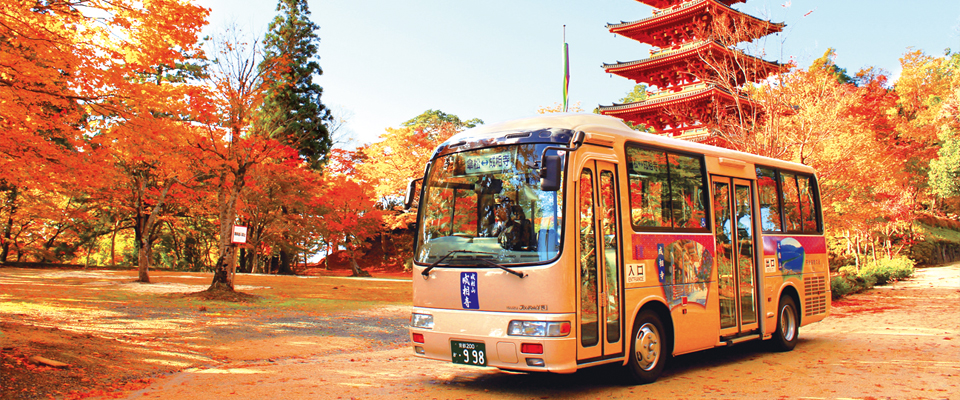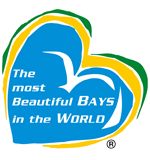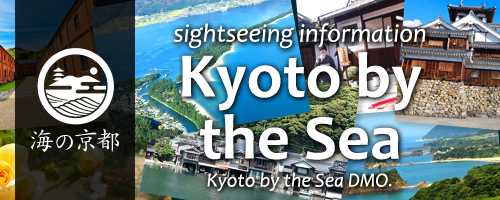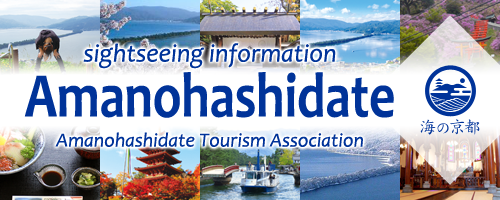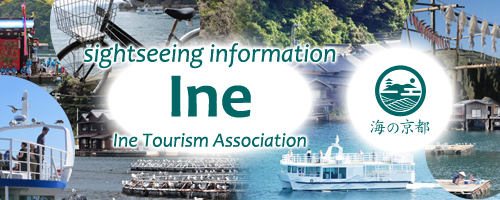Bus
Nariai Mountain Bus
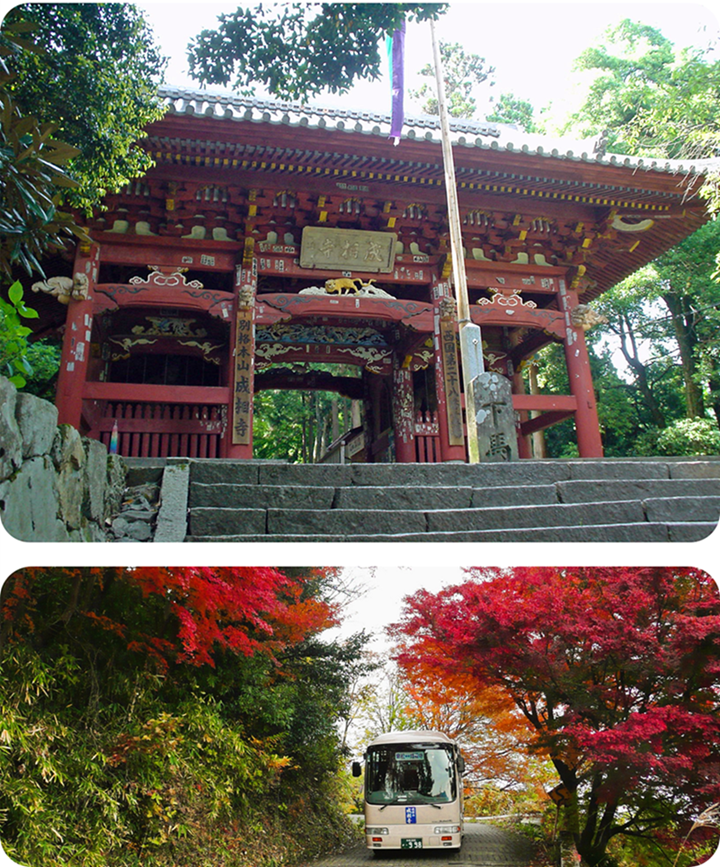
Nariaiji
Temple
Nariaiji temple, the 28th temple of the 33 Temples of Kansai Kannon Pilgrimage, was founded by the order of the Emperor Monmu in 704. This temple has a long history or tradition and possesses numerous cultural properties and it’s principal image is Sho Kanzeon Bosatsu (Avalokitesvara-bodhisattva) . It’s surroundings are rich in nature. In spring, rhododendrons are beautiful, and in autumn, the changing leaves are wonderful. The combination of this temple’s Five-Storied pagoda and autumn foliage is very photogenic!You can get there by “Nariai Mountain Bus” operated by us. The view from the windows of the bus, which follows the steep mountain ridges is also fantastic! We hope you visit.
The bus stop is in the Amanohashidate-kasamatsu Park and the ride time is about 7 minutes. The panoramic viewing platform, about 5 minutes by car or about 25 minutes on foot from the Nariaiji temple parking lot, is also recommended! Please refer to this link.
Visiting Nariaiji Temple
Opening Hours: 8:00 a.m. – 4:30 p.m. Please note that entry is not allowed outside these hours. After closing, the gates are locked and the security system is active. We appreciate your understanding.
Fare table
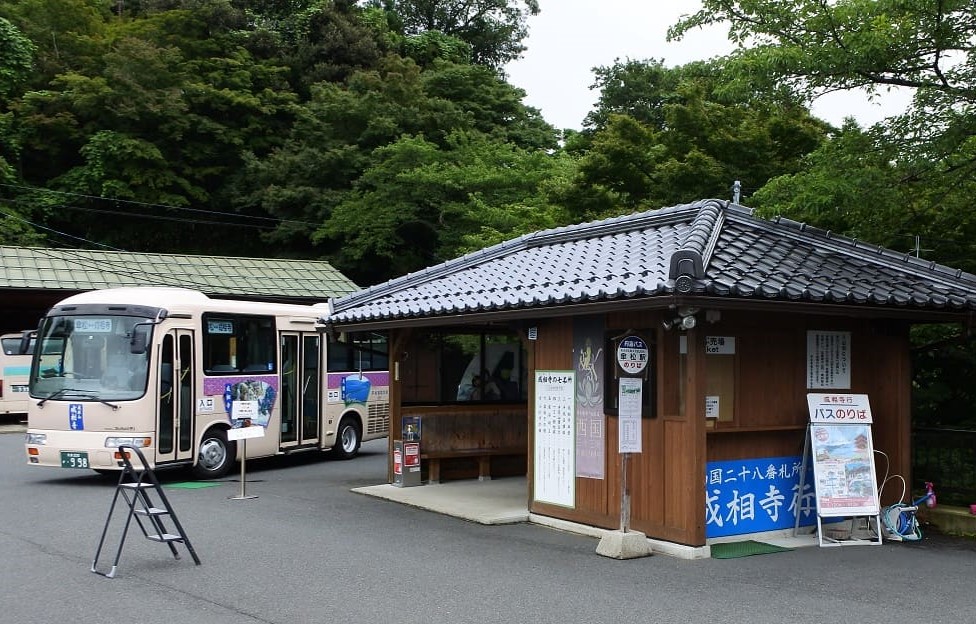
Fare for round trip including Temple Entrance fee
| 15 years old and over | 1,120 |
|---|---|
| 12-14 years old | 720 |
| 11 years old and younger | 360 |
*Entrance fee for Mt. Nariai is 400 JPY for 15 years old and over, free for 14 years old and younger.
Time table
All the times listed below will be in Japan Standard Time. The schedules marked with an asterisk (*) are operated only Saturdays, Sundays and public holidays during from 1st March to 30th November.
Time table (Weekdays)
Amanohashidate-kasamatsu park → Gate of temple → Nariaiji temple
| Bus stop | Time Table | ||||||||||||||
|---|---|---|---|---|---|---|---|---|---|---|---|---|---|---|---|
| Kasamatsu park | dep. | 9:30 AM | 10:00 AM | 10:30 AM | 11:00 AM | 11:30 AM | 12:00 PM | 12:30 PM | 1:00 PM | 1:30 PM | 2:00 PM | 2:30 PM | 3:00 PM | 3:30 PM | 4:00 PM |
| Gate of temple | 9:36 AM | 10:06 AM | 10:36 AM | 11:06 AM | 11:36 AM | 12:06 PM | 12:36 PM | 1:06 PM | 1:36 PM | 2:06 PM | 2:36 PM | 3:06 PM | 3:36 PM | 4:06 PM | |
| Nariaiji temple | arr. | 9:37 AM | 10:07 AM | 10:37 AM | 11:07 AM | 11:37 AM | 12:07 PM | 12:37 PM | 1:07 PM | 1:37 PM | 2:07 PM | 2:37 PM | 3:07 PM | 3:37 PM | 4:07 PM |
Nariaiji temple → Gate of temple → Amanohashidate-kasamatsu park
| Bus stop | Time Table | ||||||||||||||
|---|---|---|---|---|---|---|---|---|---|---|---|---|---|---|---|
| Nariaiji temple | dep. | 9:40 AM | 10:10 AM | 10:40 AM | 11:10 AM | 11:40 AM | 12:10 PM | 12:40 PM | 1:10 PM | 1:40 PM | 2:10 PM | 2:40 PM | 3:10 PM | 3:40 PM | 4:10 PM |
| Gate of temple | 9:41 AM | 10:11 AM | 10:41 AM | 11:11 AM | 11:41 AM | 12:11 pM | 12:41 PM | 1:11 PM | 1:41 PM | 2:11 PM | 2:41 PM | 3:11 PM | 3:41 PM | 4:11 PM | |
| Kasamatsu park | arr. | 9:47 AM | 10:17 AM | 10:47 AM | 11:17 AM | 11:47 AM | 12:17 PM | 12:47 PM | 1:17 PM | 1:47 PM | 2:17 PM | 2:47 PM | 3:17 PM | 3:47 PM | 4:17 PM |
Time table (Saturdays, Sundays and public holidays)
Amanohashidate-kasamatsu park → Gate of temple → Nariaiji temple
| Bus stop | Time Table | |||||||||||
|---|---|---|---|---|---|---|---|---|---|---|---|---|
| Kasamatsu park | dep. | 9:30 AM | 9:50 AM | 10:10 AM | 10:30 AM | 10:50 AM | 11:10 AM | 11:30 AM | 11:50 AM | 12:10 PM | 12:30 PM | 12:50 PM |
| Gate of temple | 9:36 AM | 9:56 AM | 10:16 AM | 10:36 AM | 10:56 AM | 11:16 AM | 11:36 AM | 11:56 AM | 12:16 PM | 12:36 PM | 12:56 PM | |
| Nariaiji temple | arr. | 9:37 AM | 9:57 AM | 10:17 AM | 10:37 AM | 10:57 AM | 11:17 AM | 11:37 AM | 11:57 AM | 12:17 PM | 12:37 PM | 12:57 PM |
| continue with the table below | ||||||||||||
| Kasamatsu park | dep. | 1:10 PM | 1:30 PM | 1:50 PM | 2:10 PM | 2:30 PM | 2:50 PM | 3:10 PM | 3:30 PM | 3:50 PM | 4:10 PM | *4:30 PM |
| Gate of temple | 1:16 PM | 1:36 PM | 1:56 PM | 2:16 PM | 2:36 PM | 2:56 PM | 3:16 PM | 3:36 PM | 3:56 PM | 4:16 PM | *4:36 PM | |
| Nariaiji temple | arr. | 1:17 PM | 1:37 PM | 1:57 PM | 2:17 PM | 2:37 PM | 2:57 PM | 3:17 PM | 3:37 PM | 3:57 PM | 4:17 PM | *4:37 PM |
Nariaiji temple → Gate of temple → Amanohashidate-kasamatsu park
| Bus stop | Time Table | |||||||||||
|---|---|---|---|---|---|---|---|---|---|---|---|---|
| Nariaiji temple | dep. | 9:40 AM | 10:00 AM | 10:20 AM | 10:40 AM | 11:00 AM | 11:20 AM | 11:40 AM | 12:00 PM | 12:20 PM | 12:40 PM | 13:00 PM |
| Gate of temple | 9:41 AM | 10:01 AM | 10:21 AM | 10:41 AM | 11:01 AM | 11:21 AM | 11:41 AM | 12:01 PM | 12:21 PM | 12:41 PM | 13:01 PM | |
| Kasamatsu park | arr. | 9:47 AM | 10:07 AM | 10:27 AM | 10:47 AM | 11:07 AM | 11:27 AM | 11:47 AM | 12:07 PM | 12:27 PM | 12:47 PM | 13:07 PM |
| continue with the table below | ||||||||||||
| Nariaiji temple | dep. | 1:20 PM | 1:40 PM | 2:00 PM | 2:20 PM | 2:40 PM | 3:00 PM | 3:20 PM | 3:40 PM | 4:00 PM | 4:20 PM | *4:40 PM |
| Gate of temple | 1:21 PM | 1:41 PM | 2:01 PM | 2:21 PM | 2:41 PM | 3:01 PM | 3:21 PM | 3:41 PM | 4:01 PM | 4:21 PM | *4:41 PM | |
| Kasamatsu Park | arr. | 1:27 PM | 1:47 PM | 2:07 PM | 2:27 PM | 2:47 PM | 3:07 PM | 3:27 PM | 3:47 PM | 4:07 PM | 4:27 PM | *4:47 PM |
On the left-hand column, you can see the list of three bus stops included on the route, with the first stops indicated towards the top, and the later stops towards the bottom. In the columns to the right, ordered by the different buses that operate on each day for this line, you can find the time that the bus leaves from each bus stop in descending order.
Value Tickets
Amanohashidate Sandbar-Ine Bay-Tango Province Sightseeing Package
This convenient and affordable set includes a round-trip ticket for the Amanohashidate cable car or chairlift, a ticket to ride the Amanohashidate sightseeing boat, the Ine Bay Boat Tour and Tankai’s route bus (except community buses) and Nariai mountain bus(temple entrance fee not included).
Amanohashidate Sightseeing Boat Trip + Cable Car/Lift Round Trip Ticket
This convenient and affordable set includes a round-trip ticket for the Amanohashidate cable car or chairlift and ticket to ride the Amanohashidate sightseeing boat. Also you can take the Nariai mountain bus(temple entrance fee not included)
Ine & Kasamatsu Tour Voucher
This convenient and affordable set includes a round-trip ticket for the Amanohashidate cable car or chairlift and a ticket to ride the Ine Bay Boat Tour. Also you can take the Nariai mountain bus(temple entrance fee not included)
The stories of Nariaiji temple
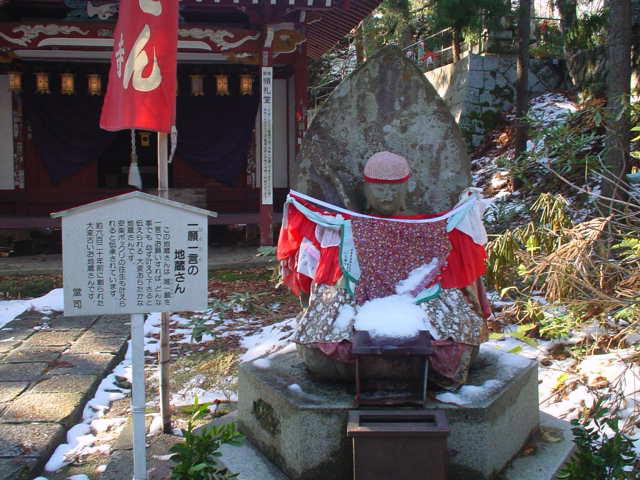
Ichigan Hitokoto Jizo
“Ichigan Hitokoto Jizo” is historic Jizo statue, thought to have been made 650 years ago. Jizo is originally known as the guardian deity of children in the Japanese culture. This Jizo is said that it will grant you only one wish if you pray. Some person whose wish came true to visit this temple to give thanks. The whole Jizo statue, including the lotus throne, are carved out a single stone. It carries a boat-shaped halo on its back, holding a Shakujo with its right hand and a Houju with its left hand. The petitioner of this Jizo statue is Zenna (善阿) who is said to be the monk of a sub-temple in Yamauti. He constructed this Jizo statue with many Buddist’s cooperation. *“Rengeza” is a seat resembling the shape of lotus flower, situated beneath a statue of Buddha. *”Funagata-kouhai” is a boat-shaped halo attached to the back of a statue. *“Shakujo” is a ritual implement shaking off the impending dangers and troubles to protect oneself. *“Houju” is a treasure which fulfills the person’s wishes just as he likes. It is also said that removes calamity and convert turbid water into clear water.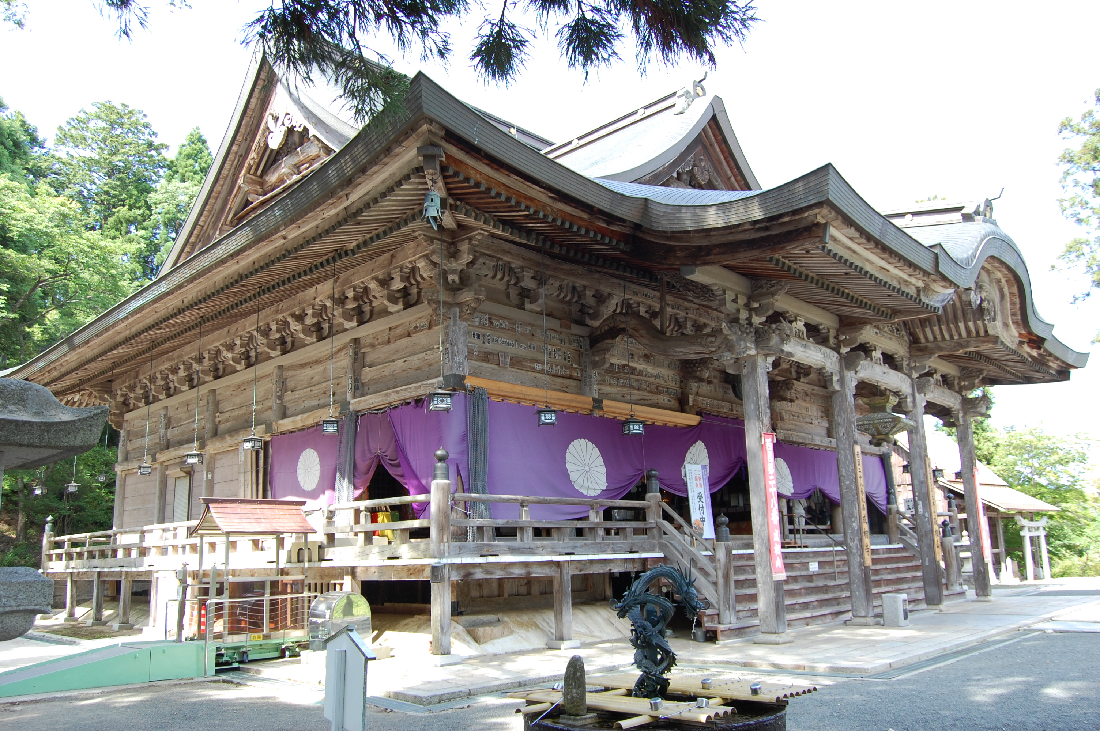
Origin of the name Nariaiji temple
From “Konjaku Monogatari-shu” (Japanese Tales from Times Past) A monk was training hard at a hermitage in the snow-covered mountains. The snow was getting deeper and the villagers stopped visiting there so the food was exhausted and he was on the verge of starvation. The monk foresaw his own death and prayed to the principal image, Kannon (The Goddess of Mercy), “Please bless me with food to survive just a day today.” Then, he didn’t know if it was a dream or reality, but he noticed that a wild boar (or a deer) hurt by a wolf had fallen outside the hermitage. The monk was religiously prohibited from eating meat. He had a hard time deciding, but he thought there was nothing more precious than life so he picked the meat off the left and right thighs of the wild boar, put it in a pot, boiled and eat.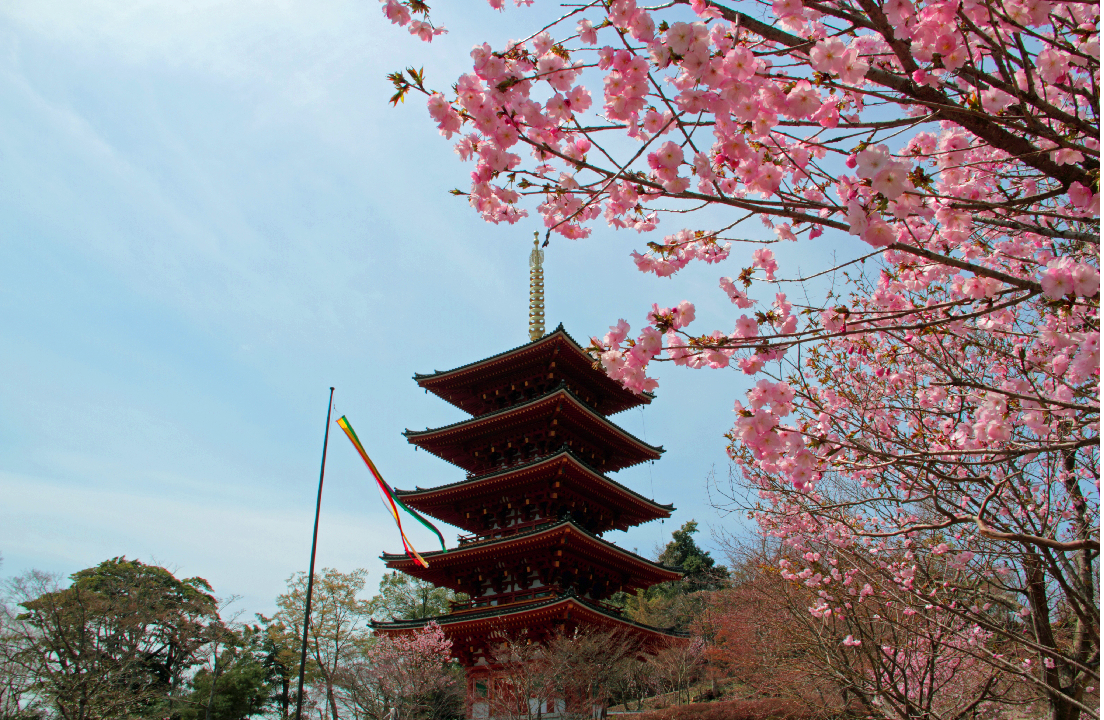
After some time, the snow thawed and the villagers climbed the mountain. Looking inside the hermitage, the left and right thighs of the statue of Kannon have been cut off, and wood chips were left in the pot. The monk heard it and noticed that Kannon saved him by sacrificing herself. The monk picked up the wood chips and put them on Kannon’s thighs, and strangely enough, her thighs were restored.
It is for this reason that it was named “The temple where grants people’s wishes (Nariaiji temple)”.
Note: “Nariau” means “wishes come true” in Japanese.

